![[Return to Physics Homepage]](./../../physics.gif)
![[Return to Mike Coombes' Homepage]](./../../coombes.gif)
![[Return to List of Handouts]](./../../handouts.gif)
![[Return to Problem Sets]](./../../problems.gif)
![[Return to List of Solutions]](./../../solutions.gif)
| Questions: | 1 | 2 | 3 | 4 | 5 | 6 | 7 | 8 | 9 | 10 | 11 | 12 | 13 | 14 | 15 | 16 | 17 | 18 | 19 | 20 | 21 | 22 | 23 | 24 | 25 | 26 | 27 | 28 | 29 | 30 | 31 |
In the diagram below, the spring has a force constant of 5000 N/m, the block has a mass of 6.20 kg, and the height h of the hill is 5.25 m. Determine the compression of the spring such that the block just makes it to the top of the hill. Assume that there are no non-conservative forces involved.

Since the problem involves a change is height and has a spring, we make use of the Generalized Work-Energy Theorem. Since the initial and final speeds are zero,
There are no nonconservative forces so WNC
= 0.
Getting x by itself yields

The only external force on the object, excluding gravity which is taken into account through gravitational potential energy, is static friction. For objects which roll across a stationary surface, static friction does no work, so here 0 = ΔE, where E is the observable or mechanical energy.
As the object drops down the hill, it loses gravitational potential energy while it gains both linear and rotational kinetic energy. Thus we have
Now since the object rolls without slipping, the angular velocity ω is related to the linear velocity v by ω = v/R. So our equation becomes
Isolating v2 terms, we find v2[m + I/R2] = 2mgH. Solving for v we get

To proceed further, we need to know the moment of inertia of each object about its CM. We consult a table of moments of inertia and find
| Shape | ICM | v |
|---|---|---|
| solid sphere | 2/5MR2 |  |
| solid cylinder | ½MR2 |  |
| hollow sphere | 2/3MR2 |  |
A cylinder of mass M and radius R, on an incline of angle θ, is attached to a spring of constant K. The spring is not stretched. Find the speed of the cylinder when it has rolled a distance L down the incline.

The only external force on the system, excluding gravity which is taken into account through gravitational potential energy, is static friction. For objects which roll across a stationary surface, static friction does no work, so here 0 = ΔE, where E is the observable or mechanical energy.
As the object rolls distance L down the incline, it loses gravitational potential energy while it gains both linear and rotational kinetic energy. Moreover, the spring gains Spring Potential Energy. Thus we have
The relationship between H and the L is H = Lsinθ. Since the object rolls without slipping, the angular velocity ω is related to the linear velocity v by ω = v/R. Furthermore, consulting a table of values, the moment of inertia of a cylinder about the perpendicular axis through the CM, is ½MR2. Our equation becomes
Isolating v2 terms, we find v2[½m + ¼m] = mgLsinθ - ½KL2. Solving for v we get

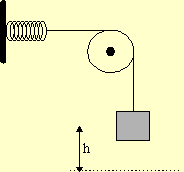
(a) The problem involves a change in height and speed and has a spring, so we would apply the generalized Work-Energy Theorem even if not directed to do,
where K is the sum of all the linear and rotational
kinetic
energies of each object, and U is the sum of the spring and
gravitational potential energies. Since there is no kinetic friction
acting on the system, WNC = 0.
Examining the problem object by object we see that
the spring
stretches, so there is an increase in spring potential energy. The
pulley starts rotating, so there is an increase in its rotational
kinetic energy. The block drops, so there is a decrease in its
gravitational potential energy. As well, as the block drop, it
increases its kinetic energy. Equation (1) for this problem is thus
Since the spring is connected to the block, the
spring stretches
as much as the block drops, so x = h. We are told that the pulley is a
solid disk, so I = ½MR2. Since the
rope does not
slip the tangential speed of the pulley is the same as the rope and
thus ω = v/R.
Substituting these relations
back into our equation yields,
Collecting the terms with v, and solving for v yields
(b) Recall from our discussions on kinematics that an object turns around when its velocity is zero. Setting equation (2) to zero
we see that the numerator is zero when
Solving this for h reveals that the object turns
around when h =
2mg/k.
(c) To find the maximum velocity, we need to find dv/dh = 0. Taking the derivative of equation (2) yields
We see that the numerator to zero when
Solving this for h reveals that the object turns around when h = mg/k, halfway between the starting position and the turnaround point.

The problem involves changes in height, speed, and
rotation, so
we would apply the generalized Work-Energy Theorem even if not directed
to do,
where K is the sum of all the linear and rotational
kinetic
energies of each object, and U is the sum of the gravitational
potential energies. Since there is no kinetic friction acting on the
system, WNC = 0.
Let's assume block 2 moves down. Thus block 1 moves
up an
identical amount h. Since block 2 drops, there is a decrease in its
gravitational potential energy. Block 1 will increase its potential
energy. As well, as both blocks move, they increases its kinetic
energy. The pulleys start rotating, so there is an increase in the
rotational kinetic energy of each. Equation (1) for this problem is
thus
We are told that Idisk =
½MD(RD)2
and Ihoop = MH(RH)2.
Since
the rope does not slip the tangential speed of the pulleys is the same
as the rope and thus ω =
v/R. Substituting
this relations back into our equation yields,
Collecting the terms with v, and solving for v yields
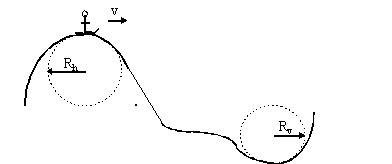
The problem involves a change in height and speed, so we
apply
the generalized Work-Energy Theorem.
There is no friction or air resistance, WNC = 0. Our equation is thus
We told what the skier feels his weight to be. The sensation of weight is N, the normal acting on the person. To find a force we need to draw a FBD and apply Newton's Second Law. We must do this both at the top of the hill and at the bottom of the valley. Since both are circular paths, we are dealing with centripetal acceleration.
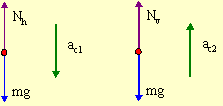 |
|
|
| ΣFy = may | ΣFy = may | |
| Nh - mg = -m(vh)2/Rh | Nv - mg = m(vv)2/Rv |
We are told that Nh = (3/8)mg, so the first force equation becomes (5/8)mg = m(vh)2/Rh. Solving for vh, we find vh = [(5/8)gRh]½. This can be substituted into equation (1)
Rearranging to isolate vv, we find
This result, along with the second force equation let's find the apparent weight in the valley,
Nv = mg + m(vv)2/Rv = mg[1+{(37/8)Rh+Rv}/Rv] = mg[2+(37/8)( Rh/Rv)] =(11.7)mg .
The skier feels 11.7 times heavier at bottom of valley - which is not very likely!
At point A in the
figure shown below, a spring (spring
constant k
= 1000 N/m) is compressed 50.0 cm by a 2.00 kg block. When released the
block travels over the frictionless track until it is launched into the
air at point B. It lands at point C. The inclined part of the track
makes an angle of θ = 55.0°
with the horizontal and point B is a height h = 4.50 m above the
ground.
How far horizontally is point C from point B?

The problem involves a change in height and speed and has a spring, so we apply the generalized Work-Energy Theorem., WNC = ΔE.
There is no friction or air resistance, so WNC
= 0. The spring is compressed initially, so it loses spring potential
energy. The block increases kinetic energy and gains gravitational
potential energy. Our equation is thus
We can use this to find the speed of the block at launch
Now the block is a projectile. To solve a projectile
problem we
break the motion into its x and y components and apply our kinematics
equations.
|
|
|
| v0x = vcos(55º) = 3.47523 m/s | v0y = vsin(55º) = 4.96314 m/s |
| Δx = ? | Δy = -4.50 m |
| ax = 0 | ay = -9.81 m/s2 |
| t = ? | t = ? |
We have enough information in the y column to find t using Δy = v0yt + ½at2 ,
Using the quadratic equation, the solutions are t =
-0.5773 s
and t = 1.5892 s. We want the positive, or forward in time, solution.
Hence the horizontal distance traveled by the block is
Point C is therefore 5.52 m from B.
A small solid
sphere of radius r = 1.00 cm and mass m =
0.100 kg
at point A is pressed against a spring and is released from rest with
the spring compressed 20.0 cm from its natural length. The spring has a
force constant k = 20.0 N/m. The sphere rolls without slipping along a
horizontal surface to point B where it smoothly continues onto a
circular track of radius R = 2.00 m. The ball finally leaves the
surface of the track at point C. Find the angle θ
where the ball leaves the track. Assume that friction does no work.
Hint
- find an expression for the speed of the sphere at point C. The moment
of inertia of a sphere is I = 2/5mr2.

The problem involves a change in height and speed and has a spring, so we apply the generalized Work-Energy Theorem., WNC = ΔE.
We are told to assume WNC = 0. The
spring is
compressed initially, so it loses spring potential energy. The ball
increases both linear and rotational kinetic energy. The ball loses
gravitational potential energy. Our equation is thus
We are told the moment of inertia, I, and we are told
that the
ball does not slip so ω
= v/r. Using some
trigonometry, the distance dropped is h = (R+r) - (R+r)cosθ.
Using these results with
equation (1) yields
We have two unknowns, v and θ. To proceed further we note that the ball loses contact with the surface. Recall that losing contact implies that N = 0. The normal is a force and to find forces we draw a FBD and apply Newton's Second Law. Since the ball moves in a circle, we are dealing with centripetal acceleration.
 |
|
| ΣFy = may | |
| N - mgcosθ = -mv2/(R+r) |
Since N = 0, and after some rearranging, the force equation yields
Substituting this into equation(2), we get
Collecting terms with cos on the left-hand side yields
Solving for θ,
The ball comes off the surface when the angle is
44.9º.
The potential
energy of a system of particles in one
dimension is
given by:
 ,
, Assuming the particle starts and ends at rest, the work
done is
Force is the negative derivative of the potential,
Thus the force at x = 1 m is
and at x = 2 m is
The equilibrium points occur at the minima and maxima of
U(x).
We find them by setting dU/dx = 0, or
This equation has roots at x = 0.211 m and x = 0.789 m.
Looking at the second derivative,
We see that when x = 0.211 m, d2U/d2x = 6 - 12(0.211) > 0, so x = 0.211 m is a minimum. We also see that when x = 0.789 m, d2U/d2x = 6 - 12(0.789) < 0, so x = 0.789 m is a maximum.
The PE curve for a
2.5-kg particle under the influence of a
conservative force is shown below. (a) What would be the total
mechanical energy of the system, if one know that the particle has a
speed of 7.5 m/s at x = 1.5 m? (b) If Etot = 150
J, where
would the particle have zero velocity? Where would the particle have
its maximum kinetic energy and what would be its speed there? (c) What
is the minimum total energy for which the particle escapes the
influence of the force creating the potential (i.e. the particle
escapes the potential well)?
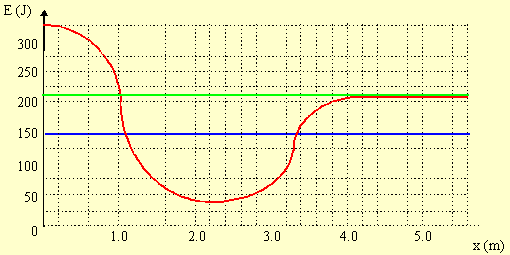
(a) The kinetic energy of the particle is
Examining the graph, at x = 1.5 m, the potential energy
approximately U = 75 J. So the total energy is Etotal =
K
+ U = 145 J.
(b) Zero velocity implies zero kinetic energy. Thus all the energy would have to be potential. Examining the graph, we see that Etotal = 150 J intercepts the potential energy curve at x = 1.1 m and at x = 3.4 m.
The maximum kinetic energy would occur where the
potential
energy is a minimum. Examining the graph the minimum potential is at x
= 2.2 m, and is 40 J. The kinetic energy is K = Etotal
- U =
150 J - 40 J = 110 J.
Since K = ½mv2
(c) Examining the graph, a particle with an energy of about 210 J could escape the potential well.

For constant forces, work is defined by W =
FΔxcos(θ).
(a) W = 36.2 J
(b) W = 77.6 J
(c) W = -38.9 J
In the diagram below, a rope with tension T = 150 N pulls a 15.0-kg block 3.0 m up an incline (θ = 25.0°). The coefficient of kinetic friction is μk = 0.20. Find the work done by each force acting on the block.

To find the work done by a force, we need to know the magnitude of the force and the angle it makes with the displacement. To find forces, we draw a FBD and use Newton's Second Law.
 |
i | j |
| ΣFx = max | ΣFy = may | |
| T - fk - mgsinθ = ma | N - mgcosθ = 0 |
The second equation informs us that N = mgcosθ. We know fk = μkN = μkmgcosθ.
| Force | Force (N) | φ | W = FΔxcosφ (J) |
| Tension | 150 | 0 | 450 |
| Weight | 147.15 | θ + π/2 | -187 |
| Normal | 133.36 | π/2 | 0 |
| Friction | 26.67 | π | -80 |
A winch lifts a 150 kg crate 3.0 m upwards with an acceleration of 0.50 m/s2. How much work is done by the winch? How much work is done by gravity?

To find the work done by a force, we need to know the magnitude of the force and the angle it makes with the displacement. To find forces, we draw a FBD and use Newton's Second Law.
 |
|
| ΣFy = may | |
| T - mg = ma |
The work done by the winch is the work done by tension. The work done by gravity is the work done by the objects weight. Since we know m and g, we find T = mg + ma = 1546.5 N. The work done by tension is Wtension = TΔycos(0) = 4.64 × 103 J. The work done by gravity is Wgravity = mgΔy cos(π) = -4.41 × 103 J.
What work does a
baseball bat do on a baseball of mass
0.325 kg
which has a forward sped of 36 m/s and a final speed of 27 m/s
backwards. Assume motion is horizontal.

Since we are asked for the work done and have a change
in
speed,
we make use of the generalized Work-Energy Theorem. Since the height of
the ball does not change, there is only a change in kinetic energy.
What is the work
done by friction in slowing a 10.5-kg
block
traveling at 5.85 m/s to a complete stop in a distance of 9.65 m? What
is the kinetic coefficient of friction?
Since we are asked for the work done and have a change
in
speed,
we make use of the generalized Work-Energy Theorem. Since the height of
the block does not change, there is only a change in kinetic energy.
To find μ, we need to know the force and the angle it makes with the displacement. To find forces, we draw a FBD and use Newton's Second Law.
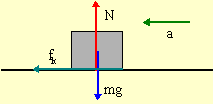 |
|
|
| ΣFx = max | ΣFy = may | |
| -fk = -ma | N - mg = 0 |
The second equation gives N = mg and we know fk
= μk
N, so fk = μk
mg. Therefore, the work done by
friction is Wfriction = -fkΔx
= -μkmgΔx.
Rearranging this yields
A 50.0-N force is applied horizontally to a 12.0-kg block which is initially at rest. After traveling 6.45 m, the speed of the block is 5.90 m/s. What is the coefficient of kinetic friction?
Since the problem involves a change is speed, we make
use
of the
Generalized Work-Energy Theorem
There are two nonconservative forces in this problem, friction and the applied force. The work done by friction is given by Wfriction = -fkΔx. The work done by the applied force is WF = FΔx.
To find out more about fk, we draw a FBD and use Newton's Second Law.
 |
|
|
| ΣFx = max | ΣFy = may | |
| F - fk = ma | N - mg = 0 |
The second equation gives N = mg and we know fk
= μkN,
so fk = μkmg.
Thus Wfriction = -μkmgΔx.
Combining this result with equation (1), we get
Rearranging yields an expression for μk
Using the given values, we find μk = 0.15 .
A rope is wrapped abound a cylindrical drum as shown below. It is pulled with a constant tension of 100 N for six revolutions of the drum. The drum has a radius of 0.500 m. A brake is also applying a force to the drum. The brake pushes inwards on the drum with a force of 200 N. The pressure point is 0.350 m from the centre of the drum. The coefficient of kinetic friction between the brake and the drum is 0.50. Determine the work done by each torque.
 |
 |
Work is defined by the formula W =
τΔφ
in rotational cases. Since the rope does not slip as it is pulled, the
object rotates 6 times clockwise or Δφ
= -12π. We know fk
= μkN.
In this problem, N equals how hard the brake is pressed. Note that the
tension and the friction are tangential to the drum.
(a) WT = (-RT)Δφ = -(0.5m)(100 N)(-12π) = 1.88 × 103 J.
(b) Wf = (rfk)Δφ = (0.35 m)(0.50 × 200 N)(-12π) = -1.32 × 103 J.
Determine the work
done by the following. Determine the
angles
between the forces and the displacements. The forces are in Newtons and
the displacements are in metres:
In 3D, work is defined W = F ·
Δr,
which means W = FxΔx + FyΔy
+ FzΔz.
It is also defined by W = FΔrcosθ,
where F and R are the magnitudes of the
vectors, F and Δr.
Using the
3D version of Pythagoras' Theorem, F = [(Fx)2
+ (Fy)2
+ (Fz)2]½
and Δr
= [(Δx)2 + (Δy)2
+ (Δz)2]½.
If we
find the work using the first form, then θ
can be found from the second by θ = cos-1(W
/ FΔr).
(a) W = 1×4 + 2×5 + 3×6 = 32 J.
Since F = [(1)2 + (2)2 + (3)2]½ = 3.7417 N and Δr = [(4)2 + (5)2 + (6)2]½ = 8.7750 m, then θ = cos-1(W / FΔr) = 12.9º.
(b) W = 1×4 + 2×5 + 3×(-6) = -4 J.
Since F = [(1)2 + (2)2
+ (3)2]½
= 3.7417 N and Δr = [(4)2 + (5)2
+ (-6)2]½ =
8.7750 m, then θ = cos-1(W
/ FΔr)
= 97.0º.
(c) W = 4×2 + 2×(-8) + 4×2 = 0 J.
Since F = [(4)2 + (2)2
+ (4)2]½
= 6.1644 N and Δr = [(2)2 + (-8)2
+ (2)2]½ =
8.4853 m, then θ = cos-1(W
/ FΔr)
= 90º.
In the diagram below, a 5.00-kg block slides from rest at a height of h1 = 1.75 m down to a horizontal surface where it passes over a 2.00 m rough patch. The rough patch has a coefficient of kinetic friction μk = 0.25. What height, h2, does the block reach on the θ = 30.0° incline?

Since the problem involves a change of height and
speed,
we make
use of the Generalized Work-Energy Theorem. Since the block's initial
and final speeds are zero, we have
The nonconservative force in this problem is friction. To find the work done by friction, we need to know the friction. To find friction, a force, we draw a FBD at the rough surface and use Newton's Second Law.
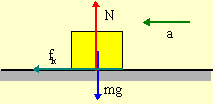 |
|
|
| ΣFx = max | ΣFy = may | |
| -fk = -ma | N - mg = 0 |
The second equation gives N = mg and we know fk
= μkN,
so fk = μkmg.
Therefore, the work done by
friction is Wfriction = -fkΔx
= -μkmgΔx.
Putting this into equation (1) yields
Solving for h2, we find
In the diagram below, a 5.00-kg block slides from rest at a height of h1 = 1.75 m down to a smooth horizontal surface until it encounters a rough incline. The incline has a coefficient of kinetic friction μk = 0.25. What height, h2, does the block reach on the θ = 30.0° incline?

Since the problem involves a change of height and
speed,
we make
use of the Generalized Work-Energy Theorem. Since the block's initial
and final speeds are zero, we have
The nonconservative force in this problem is friction. To find the work done by friction, we need to know the friction. To find friction, a force, we draw a FBD at the rough surface and use Newton's Second Law.
 |
|
|
| ΣFx = max | ΣFy = may | |
| -fk - mgsinθ = -ma | N - mgcosθ = 0 |
The second equation gives N = mgcosθ
and we know fk = μkN,
so fk = μk
mgcosθ. Therefore, the work done by
friction is Wfriction
= -fkΔx = -μkmg
cosθΔx. Putting this into
equation (1)
yields
A little trigonometry shows that Δx
is related to h2 by Δx = h2
/ sinθ. Putting this into the above equation
yields
Solving for h2, we find
A rope is wrapped
exactly three times around a cylinder
with a
fixed axis of rotation at its centre. The cylinder has a mass of 250 kg
and a diameter of 34.0 cm. The rope is pulled with a constant tension
of 12.6 N. The moment of inertia of a cylinder about its centre is I =
½MR2. (a) What is the work down by
the rope as it is
pulled off the cylinder. Note that the rope does not slip. (b) If the
cylinder was initially at rest, what is its final angular velocity?
Note that ropes are always tangential to the surfaces that they are
wrapped around. Note that the work done by the tension is
non-conservative.

Since the problem involves a change is speed, we make
use
of the
Generalized Work-Energy Theorem. Since there is only a change in
rotational speed,
The nonconservative force in this problem is tension, WNC
= WT. So we have
(a) The definition of work in rotational situations is W = τΔφ. Tension is always tangential to cylinders so τT = -RT. Since the rope does not slip, the cylinder rotates clockwise three times so Δφ = -6π. We can thus find the work done by the tension
(b) Then we find the final velocity from equation (1),
According to the table of Moments of Inertia, I =
½MR2
for a solid cylinder. So
Suppose that there is friction in problem 12 and that the compression must in fact be 0.425 m for the block to just reach the top of the hill. What work is done by the frictional force?
Friction is a nonconservative forces so WNC = Wfriction ¹ 0. Thus
Friction does -132 Joules of work.
A large cylinder of
mass M = 150 kg and radius R = 0.350
m.
The
axle on which the cylinder rotates is NOT frictionless. A rope is
wrapped around the cylinder exactly ten times. From rest, the rope is
pulled with a constant tension of 25.0 N. The rope does not slip and
when the rope comes free, the cylinder has a forward angular velocity f
= 10.5 rad/s. The moment of inertia of a cylinder is I = ½MR2.
(a) What angle was the cylinder rotated through?
(b) What is the frictional torque of the axle?
(c) How long will it take the frictional torque to bring the cylinder
to a stop?
(d) How many revolutions will it have turned?
(a) Since the rope does not slip, the cylinder rotates ten times so Δφ = -20π, where the rotation is assumed to be clockwise.
(b) Since the problem involves forces and a change is rotational speed, we make use of the Generalized Work-Energy Theorem. Since there is only a change in rotational kinetic energy,
The nonconservative forces in this problem are the
tension and
the axle friction, WNC = WT
+ Wf. So we
have
The definition of work in rotational situations is W =
τΔφ. Tension is always tangential
to cylinders
so τT
= -RT, again assuming the
rope pulls the cylinder clockwise. Thus the work done by the tension is
Using this result and equation (1), we can find the
work
done by
friction
Since Wf = τf Δφ, we find the frictional torque to be
the sign indicating that it is counterclockwise.
(c) After the rope comes off the cylinder, the only
force
acting
is friction so the generalized Work-Energy Theorem becomes
where ω0 here is ωf from the first part of the problem and the new ωf = 0 since the drum comes to a stop. Again Wf = τfΔφ, where τf is the result from part (b). Therefore
(d) To find the time it takes to slow down, note that we have the initial and final angular velocities and the angular displacement. Referring to our kinematics equations, we find
Rearranging for t yields,
A person with an
axe to grind is using a whetstone. The
whetstone
is connected to a motor which keeps it rotating at 85 rev/min. The
whetstone is a solid cylinder of made of a special type of stone of
mass 45 kg and radius 20 cm. The heavy axe-blade is being pressed onto
the whetstone with a steady force of 25 N directed into the centre of
the whetstone. Suddenly, the power to the motor is cut but the person
maintains the force of the axe on the whetstone. The coefficient of
kinetic friction between the axe and the stone is 0.60. The moment of
inertia of a cylinder about it's centre of mass is I = ½MR2.
(a) Calculate the torque of the frictional force on the wheel.
(b) Calculate the total angle through which the wheel turns from the
time the power goes off to the time the whetstone stops rotating.
(c) How long does it take for the wheel to stop after the power outage?
 |
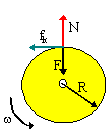 |
(a) The frictional force is tangential to the surface of the whetstone. The friction torque is τf = Rfk. The frictional force is given by fk = μN. According to Newton's Third Law, the normal is equal to the force pressing the axe into the whetstone. Hence
(b) Since the object is rotating and we are given speeds, we apply the generalized Work-Energy Theorem. Note that we only have rotational kinetic energy, so
where WNC is the work done by
friction in slowing the
whetstone and we used the given I. The angular velocity is given in
rev/min but in SI units it is
The definition of work is WNC =
τf Δφ. If we use this
relation, we
find that
(c) To find the time it takes to slow down, note that we have the initial and final angular velocities and the angular displacement. Referring to our kinematics equations, we find
Rearranging for t yields,
In the figure below, a block of mass 5.0 kg starts at point A with a speed of 15.0 m/s on a flat frictionless surface. At point B, it encounters an incline with coefficient of kinetic friction μk = 0.15. The block makes it up the incline to a second flat frictionless surface. What is the work done by friction? What is the velocity of the block at point C? The incline is 2.2 m long at an angle θ = 15°.

The problem involves a change in height and speed, so
we
apply
the generalized Work-Energy Theorem.
Here the nonconservative force is friction, so WNC = Wf. To find friction, a force, we draw a FBD and use Newton's Second Law.
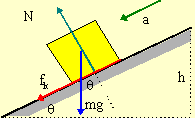 |
|
|
| ΣFx = max | ΣFy = may | |
| -fk - mgsinθ = -ma | N - mgcosθ = 0 |
The second equation gives N = mgcosθ
and we know fk = μkN,
so fk = μkmgcos
θ. Therefore, the work done by
friction is
Note from the diagram, that the height h is related to
the
length of the incline by h = Δxsinθ.
Putting both results into equation (1) yields
Solving for vC yields
In the diagram block M1 is connected to M2 by a very light string running over three identical pulleys. The pulleys are disks with mass Mp and the rope does not slip. The coefficient of kinetic friction for the horizontal surface that M1 is on is μk. Find an expression for the speed v of block M2 in terms of the distance L that block M1 moves to the right. Your answer should be expressed in terms of L, M1, M2, Mp, μk, and g only. Hint: work and energy methods provide the quickest solution.
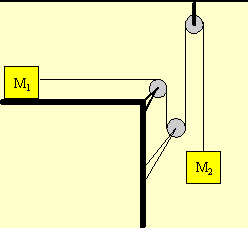
The problem involves changes in height, speed, and rotation, so we would apply the generalized Work-Energy Theorem even if not directed to do so,
where K is the sum of all the linear and rotational kinetic energies of each object, and U is the sum of the gravitational potential energies. Since there is kinetic friction acting on the system, WNC = Wf. To find Wf, we need to the frictional force. To find a force, we draw a FBD and use Newton's Second Law.
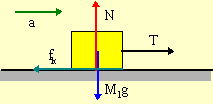 |
|
|
| ΣFx = max | ΣFy = may | |
| T - fk = M1a | N - M1g = 0 |
The second equation gives N = M1g
and we know fk
= μk N, so fk =
μkM1g.
Therefore, the work
done by friction is Wf = -fk
Δx
= -μ kM1gΔx.
Next consider the change in energy of each object. M1
increases its linear kinetic energy. M2 also
increases its
linear kinetic energy but loses gravitational potential energy. The
three identical pulleys increase their rotational kinetic energies.
Thus equation (1) becomes
Since M1 and M2
are connected by the same
rope, they have the same speed and move the same distance so that
Δx = h. Consulting a table of
Moments of
Inertia, we find Idisk = ½MPR2.
Since the rope does not slip, the tangential speed of the pulleys is
the
same as the rope and thus ω
= v/R.
Substituting this relations back into our equation yields,
Collecting the terms with v yields
Solving for v yields,
Tarzan, Lord of
Apes, is swinging through the jungle. In
the
diagram below, Tarzan is standing at point A on a tree branch h1
=
22.0 m above the floor of the jungle. Tarzan is holding one end of a
vine which is attached to a branch on a second tree. The vine is L =
21.0 m long. When Tarzan swings on the vine, his path is in an arc of a
circle. At the bottom of his swing he is at point B, 13.0 m above the
ground . Ignore Tarzan's height. Tarzan has a mass of 90.0 kg. The vine
does not stretch and has negligible mass.
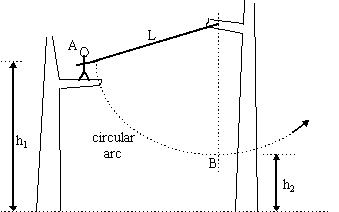
The problem involves a change in height and speed, so
we
apply
the generalized Work-Energy Theorem.
(a) Here the only possible nonconservative force is friction, so WNC = WT. The definition of work is W = FΔxcosθ, but in this problem the tension is along a radius and is thus always at 90º to the displacement. As a result, WT = 0. Thus we have
(b) To find the speed at point B, we need to know h, the distance Tarzan dropped. Examining the question, we see that h = h1 - h2 = 22.0 m - 13.0 m = 9.0 m. Rearranging our equation, we find
(c) Tension is a force. To find a force we need to draw a FBD and apply Newton's Second Law. Since Tarzan is swinging in a circle, we are dealing with centripetal acceleration.
 |
|
| ΣFy = may | |
| T - mg = mv2/L |
Solving for T,
A block of mass M on a flat table is connected by a string of negligible mass to a vertical spring with spring constant K which is fixed to the floor. The string goes over a pulley that is a solid disk of mass M and radius R. As shown in the diagram below, the spring is initially in its equilibrium position and the system is not moving. A person pulls the block with force F through a distance L. Determine the speed v of the block after it has moved distance L.The tabletop is frictionless.

The problem involves changes in height, speed, and rotation, so we would apply the generalized Work-Energy Theorem even if not directed to do so,
where E is the sum of all the mechanical energies of each object. If the system consists of the spring, string, pulley, block and the earth, then F is an external force acting on the system and Wext = FL.
Next consider the change in energy of each object. The spring stretches as so increases its potential energy. The pulley turns from rest so increases its rotational kinetic energy. The block moves from rest so it increases its linear kinetic energy. Thus equation (1) becomes
Since the block and spring are connected by the same string, the spring has stretched x = L. Consulting a table of Moments of Inertia, we find Idisk = ½MR2. Since the string does not slip, the tangential speed of the pulleys is the same as the rope and thus ω = v/R. Substituting this relations back
Collecting the terms with v yields
3/4Mv2 = FL – ½KL2 .
Solving for v yields,
v = [(4M – 2KL2) / 3M]½ .
The power required to move the block at constant speed is P = Fv. We are given v, the speed of the block. To get F, a force, we draw a FBD and apply Newton's Second Law,
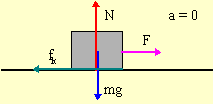 |
|
|
| ΣFx = max | ΣFy = may | |
| F - fk = 0 | N - mg = 0 |
The second equation gives N = mg and we know fk
= μkN,
so fk = μkmg.
Therefore, the applied force is
F = μkmg. Thus the power is
A 7500 W engine is
propelling a boat at 12 km/h. What
force
is
the engine exerting on the boat? What force and how much power is water
resistance exerting on the speedboat?
First we convert the velocity to SI units,
We know P = Fv, so
By Newton's Third Law, the water is exerting 2250 N in the reverse direction. It is also removing 7500 W of power which is going into increasing the kinetic energy of the water.
A 3.0 hp engine
pulls a 245-kg block at constant speed up
a
12.0
m 30.0° incline.
How long does this take?
Ignore friction.
First, 3.0 hp × 746 W / hp = 2238 W.
Next, the work done by the engine must equal the work
done by
the weight, from Newton's Third Law. The work done by gravity is
Since power is defined as work over time, P = W/t, the
time it
takes is
Questions? mike.coombes@kwantlen.bc.ca